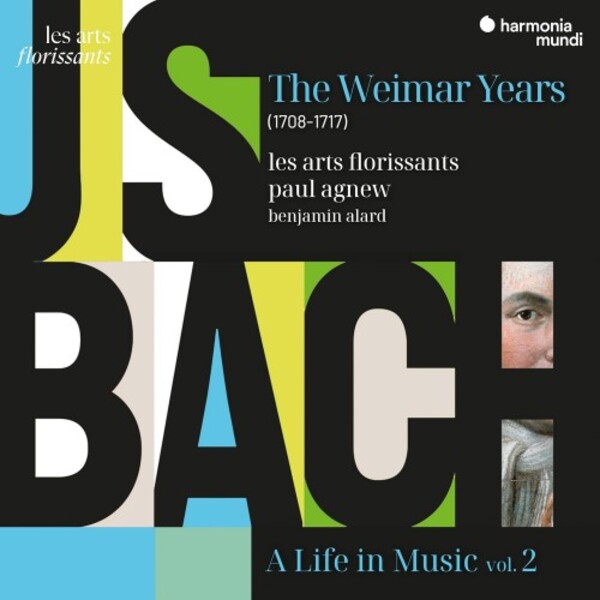JS BACH A Life in Music vol 2 - the Weimar Years
View record and artist detailsRecord and Artist Details
Genre:
Vocal
Label: Harmonia Mundi
Magazine Review Date: 05/2025
Media Format: CD or Download
Media Runtime: 77
Mastering:
DDD
Catalogue Number: HAF890 2728

Tracks:
| Composition | Artist Credit |
|---|---|
| Cantata No. 12, 'Weinen, Klagen, Sorgen, Zagen' |
Johann Sebastian Bach, Composer
(Les) Arts Florissants Vocal Ensemble Paul Agnew, Conductor |
| Nun komm, der Heiden Heiland |
Georg Philipp Telemann, Composer
(Les) Arts Florissants Vocal Ensemble Paul Agnew, Conductor |
| Cantata No. 61, 'Nun komm, der Heiden Heiland' |
Johann Sebastian Bach, Composer
(Les) Arts Florissants Vocal Ensemble Paul Agnew, Conductor |
| Cantata No. 182, 'Himmelskönig, sei willkommen' |
Johann Sebastian Bach, Composer
(Les) Arts Florissants Vocal Ensemble Paul Agnew, Conductor |
Author: Jonathan Freeman-Attwood
Whether in the wailing lamentation of Weinen, Klagen or the regal anticipation of the birth of Christ in Nun komm, der Heiden Heiland, the Weimar cantatas show how the young Bach’s growing technical command – in the relatively undemanding context of a single monthly cantata – gave him the licence to explore a whole new range of ideas ‘from behind the text’. No wonder smaller groups in recent years have gravitated towards their intimacy of expression and prodigious spirit of discovery. Each of the three cantatas here represents a significant milestone in Bach’s journey. As Susan McClary aptly writes in her note: ‘The Bach we know has arrived.’
This second volume of early Bach from Les Arts Florissants is another thoughtfully rich exploration. Undogmatic about forces or format, Agnew achieves from the outset an exceptional alliance between singers and instrumentalists, evident in the sublime obbligato oboe-playing of the opening sinfonia of No 12 and the way it sets up the darting afflictions in the French-style tombeau. This is the plangent opening choral movement that Bach considered powerful enough to return to 30 years later for the ‘Crucifixus’ in his Mass in B minor. It is a persuasive reading, with a pair of highly refined arias from Edward Grint (whose discipleship is palpable) and the seasoned Bach tenor Thomas Hobbs. The latter’s ‘Sei getreu’ (‘Be faithful’) – and with the chorale played on a stratospheric trumpet – is quite a tour de force, especially given that Agnew chooses to perform the work in the higher Chorton pitch (as standard in German organs at the time).
Pitch plays a part in a luminous performance of No 61, a work that Bach revisited on the equivalent Advent Sunday in his first year in Leipzig. Lean and tensile, Agnew conceives this as a kind of pressure hose on mankind – ridding it of the layered sinfulness of the past and preparing the way for the New Testament. Less consistent is the way singers and instrumentalists respond to the higher pitch in No 182, a Palm Sunday work of Italianate virtuosity; the Sonata is consistently flat, and this pervades pockets of a cantata that otherwise brims with vim and variety.
As with Vol 1’s inclusion of Kuhnau’s Christ lag in Todesbanden (6/24), Bach is contextualised here in Telemann’s own Nun komm, der Heiden Heiland. The setting is a world away from Bach, which is clearly the point. While fascinating to observe how Telemann can airbrush out the conceit of ‘impatient longing’ to save the heathen (in favour of Enlightenment suavity), it simply reinforces Bach’s magnitude.
Discover the world's largest classical music catalogue with Presto Music.

Gramophone Digital Club
- Digital Edition
- Digital Archive
- Reviews Database
- Full website access
From £8.75 / month
Subscribe
Gramophone Full Club
- Print Edition
- Digital Edition
- Digital Archive
- Reviews Database
- Full website access
From £11.00 / month
Subscribe
If you are a library, university or other organisation that would be interested in an institutional subscription to Gramophone please click here for further information.




